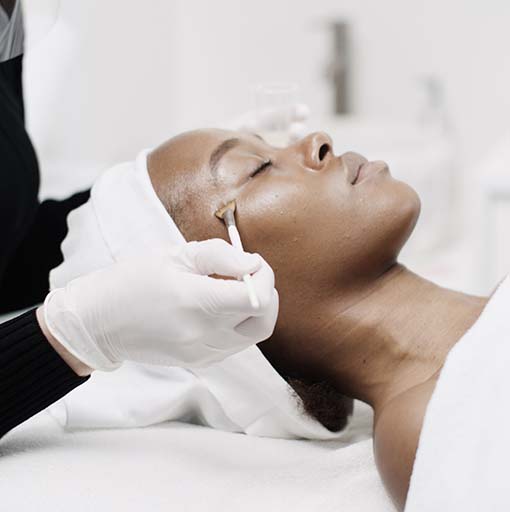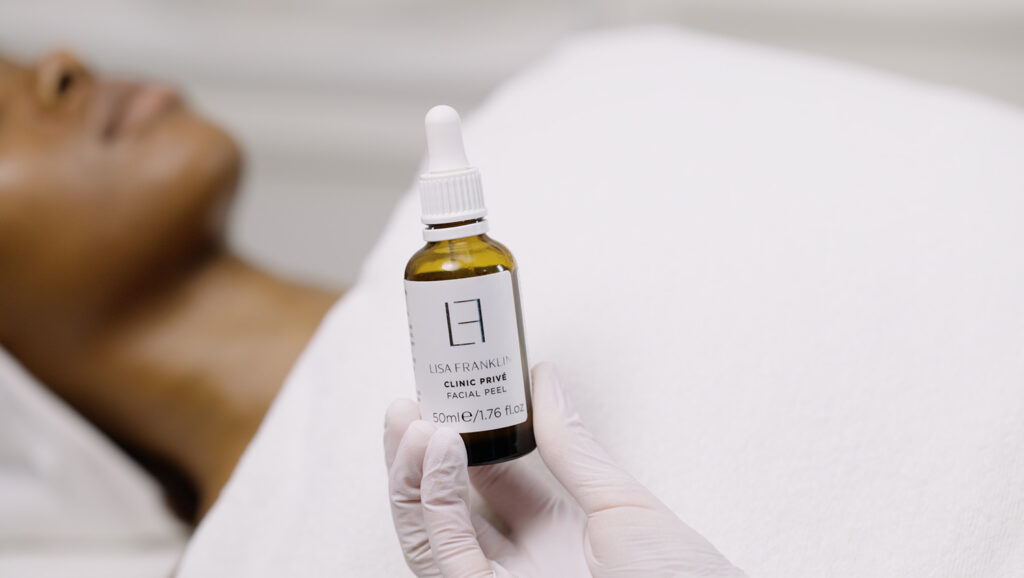The Edit | Skincare Blog
Home / The Edit | Skincare Blog / Are Chemical Peels Safe?
Are Chemical Peels Safe?

Chemical peels, whether superficial, medium, or deep, play a transformative role in addressing a range of skin concerns, such as uneven skin tone, acne scarring, and fine lines and wrinkles.
At Lisa Franklin, we leverage our expertise to customize these peels with powerful ingredients like glycolic acid, salicylic acid, lactic acid, and mandelic acid. By using these specific formulations, we help clients achieve smoother, healthier skin by removing damaged cells and stimulating the regeneration of fresh, new skin.
When considering the safety of chemical peels, it’s important to examine the different peel depths and how they cater to various skin types. We also address specific concerns, such as unusual scarring tendencies, while accounting for factors like sun exposure and family history.
With Lisa Franklin’s guidance, clients are empowered to make well-informed decisions about safely incorporating chemical peels into their personalized skincare routines.
What are Chemical Peels?
Chemical peels rejuvenate the skin by exfoliating its outermost layer through the application of a chemical solution. These treatments come in varying depths—superficial, medium, and deep—to target specific skin concerns. Each type of peel is designed to address different issues, ensuring a tailored approach for individual skin needs.
Types of Chemical Peels
-
- Superficial peels typically use alpha hydroxy acids, such as glycolic acid, to enhance skin texture and address uneven skin tone.
- Medium peels, often incorporating trichloroacetic acid, penetrate deeper to target acne scars and sun damage.
- Deep peels containing phenol reach the deeper skin layers, reducing severe wrinkles and deep scars
Chemical peels actively promote skin renewal by removing damaged cells, which in turn encourages the growth of new, healthier skin. When considering chemical peels, it’s essential to factor in your skin type, sun exposure and family history.
At Lisa Franklin, we excel in cosmetic procedures and focus on providing personalised treatments tailored to meet individual needs. Additionally, we guide you on essential post-treatment care, such as sun protection and prescribed medication use. Moreover, when administered by our skilled dermatologist, chemical peels can offer a transformative solution. They help you achieve smoother, rejuvenated skin with minimal downtime.
Benefits of Chemical Peels
Chemical peels offer numerous benefits, making them a versatile and effective solution for various skin concerns.
Improved Skin Texture:
Whether you choose a superficial or deep chemical peel, these treatments exfoliate the outer layer of your skin, promoting the regeneration of new, smoother skin.
Address Uneven Skin Tone:
Peels, especially those with glycolic or salicylic acid, help even out skin tone by targeting hyperpigmentation and encouraging a more balanced complexion.
Treatment for Acne Scarring:
Medium and deep peels, using ingredients like trichloroacetic acid, can significantly reduce acne scars, offering a transformative solution for smoother skin.
Effective for Sun Damage:
Chemical peels are excellent for treating sun damage and melasma. They help minimise sunspots and can reverse the effects of prolonged sun exposure.
Rejuvenation for Darker Skin Tones:
With careful selection of specific acids and treatment depths, chemical peels can be customised for individuals with darker skin tones, addressing issues like unusual scarring tendencies.
Reduction of Fine Lines and Wrinkles:
Medium and deep peels stimulate collagen production, reducing the appearance of fine lines and more severe wrinkles.
Versatility in Cosmetic Treatments:
Chemical peels can be paired with other cosmetic procedures, such as laser therapy, for comprehensive rejuvenation.
Minimisation of Enlarged Pores:
Superficial and medium peels help reduce the appearance of enlarged pores, resulting in a refined, more even skin tone.
Customisable for Skin Types:
Chemical peels can be adapted to suit different skin types, ensuring that people with varying skin tones and textures benefit from the treatment.
Boosted Effectiveness with Repeat Treatments:
Although one treatment can yield noticeable results, repeat sessions can further enhance and maintain the skin’s rejuvenation over time.

Risks and Side Effects
Although chemical peels are highly effective, it’s important to recognise the potential risks and side effects that come with different peel depths and varying skin types. By consulting with a qualified dermatologist, such as our experts here at Lisa Franklin, and carefully following post-treatment care instructions, you can significantly reduce these risks while ensuring the procedure remains safe and effective.

Contradictions and Precautions
When considering chemical peels, it’s imperative to be aware of potential contraindications and follow essential precautions to achieve a safe and effective result. The depth of the peel significantly impacts these considerations.
For example, while superficial peels are generally safe, individuals with cold sores or uneven skin tone should proceed with caution. On the other hand, medium chemical peels require careful assessment, particularly for those prone to hyperpigmentation or cold sores. Deep peels demand even more consideration, especially for those with a history of scarring, abnormal scarring tendencies, or increased sun sensitivity.
In general, it’s important to address specific factors, such as managing cold sores with antiviral medication. Additionally, consulting a dermatologist is recommended for those on certain medications. During the initial healing period, it’s wise to minimise makeup use. Strict sun protection is essential throughout, as is selecting a peel that suits your individual skin tone. Furthermore, assessing the compatibility of chemical peels with other cosmetic treatments is key.
After the treatment, following post-procedure precautions is vital. This includes careful wound care, monitoring for any changes in skin colour and choosing a reputable outpatient surgical facility for any necessary follow-up.
Choosing the best aesthetic clinic
Choosing the best aesthetic clinic for chemical peels is a critical step in ensuring a safe and effective cosmetic procedure. Whether opting for a superficial, medium, or deep chemical peel, the expertise of the skin specialist or dermatologist is paramount.
We have professionals here at Lisa Franklin, who have a wealth of experience, can tailor the peel to specific skin types and concerns, such as uneven skin tone, acne scarring, fine line and wrinkles. They possess the knowledge to select the appropriate acids, like glycolic or salicylic acid, and determine the ideal depth, whether superficial, medium, or deep.
A skilled professional will guide individuals on precautions, such as managing cold sores with antiviral medication, avoiding makeup during the initial healing period, and emphasising sun protection to prevent post-inflammatory hyperpigmentation. Choosing a clinic with a thorough understanding of various skin tones, familiarity with diverse cosmetic treatments and access to reputable outpatient facilities is vital for a successful chemical peel experience, minimising risks and maximising results.
Preparing for a Chemical Peel
Consultation with a Dermatologist or Skin Specialist:
Start by scheduling a comprehensive consultation with a qualified dermatologist, such as Lisa Franklin. During this consultation, you will have the opportunity to discuss your specific skin concerns, which may include acne scarring, lines and wrinkles, or uneven skin texture.
Assessment of Skin Type and Concerns:
During the consultation, you will work with the specialist to determine your skin type and identify the specific issues you wish to address. Factors such as darker skin tones and any unusual scarring tendencies will be taken into consideration.
Discussion of Treatment Options:
Next, engage in a thorough discussion about the various treatment options available. You will explore choices between superficial, light chemical peels, and medium-depth peels, while learning about the potential benefits of acids like lactic acid or trichloroacetic acid.
Pre-Treatment Recommendations:
Before your treatment, follow the pre-treatment recommendations provided by the specialist. These may include discontinuing certain skincare products or medications, such as retinoid creams or oral antibiotics.
Avoidance of Sun Exposure:
In the weeks leading up to the chemical peel, it’s crucial to minimise sun exposure. Regular use of sunscreen will help protect your skin from any potential sun damage.
Moisturising Routine:
To promote optimal healing after the peel, maintain a consistent moisturising routine. Keeping the skin hydrated and healthy will contribute to better results post-treatment.
Limitation of Makeup:
On the day of the chemical peel, avoid wearing makeup. This will ensure that the treatment area is clean and ready for the chemical peeling process, helping to facilitate the best outcome.
Awareness of Post-Treatment Effects:
Make sure you are aware of potential post-treatment effects, such as brownish discolouration or post-inflammatory hyperpigmentation, especially if you have brown or black skin. Discuss these concerns with your specialists beforehand.
Hair Removal Considerations:
If you have recently undergone hair removal treatments or have plans for such treatments, it’s important to inform the specialist, as this could affect the peel treatment.
Moisturiser Application:
In the days leading up to the peel, apply a premium quality moisturiser to enhance skin hydration. This will minimise the risk of excessive dryness after the peel.
Avoidance of Facial Scrubs:
A week before the treatment, discontinue the use of facial scrubs or exfoliants to prevent irritation and ensure your skin is in the best condition for the peel
The Chemical Peel Process
The chemical peel process consists of several steps, which work together to rejuvenate and enhance your skin’s appearance.
Consultation
To begin, schedule a consultation where you can discuss your skin concerns and goals with a qualified skincare professional.
Skin Assessment
First, determine your skin type and concerns, then choose the appropriate chemical peel—whether it’s superficial, medium, or deep.
Preparation
To prepare for your treatment, make sure to follow all pre-treatment recommendations. Discontinue any specific skincare products or medications as instructed.
Cleansing
Start by thoroughly cleansing the treatment area to effectively remove makeup, oil and any debris.
Application of Chemical Solution
Next, apply a tailored chemical solution, such as glycolic or salicylic acid, to trigger controlled exfoliation.
Peeling Process
By removing the outer skin layers during the peeling process, you stimulate cell turnover and boost collagen production.
Here’s a revised version of your content, focusing on reducing the passive voice, incorporating more transition words, and limiting sentences to 20 words or fewer where possible.
Sensation and Duration
You may experience a mild tingling or burning sensation, with the duration depending on the type of peel.
Neutralisation (if applicable)
For certain peels, neutralisation is necessary to stop the chemical reaction and complete the process.
Post-Peel Care
You will receive detailed instructions on skincare, sun protection, and product use following the treatment.
Healing Period
Allow your skin to heal naturally, which may involve peeling, redness, or temporary texture changes.
Follow-up Appointments
Schedule regular follow-up appointments to track your progress and make any necessary adjustments to your skincare routine.
Long-Term Skincare
Incorporate long-term skincare practices such as regular sunscreen use and maintenance treatments. Seeking expert guidance from a professional like Lisa Franklin ensures a safe, personalised chemical peel experience.
Aftercare and Recovery
After your chemical peel, proper aftercare is essential for optimal results and skin health. Post-treatment, you may experience varying levels of redness, peeling, or sensitivity, depending on the peel’s depth. Adhering to post-peel care instructions, including gentle cleansing, moisturising, and daily sunscreen application, protects your newly revealed skin.
It’s important to avoid sun exposure, makeup, and strenuous activities during the initial healing phase. In some cases, specific post-peel products or medications may be necessary for faster recovery. Regular follow-up visits allow your skincare professional to monitor progress and provide guidance on maintaining results. With Lisa Franklin’s expert care, you receive a tailored aftercare plan that promotes smooth and successful recovery.
In Conclusion
In summary, when performed by skilled professionals like those at Lisa Franklin Clinic Privé, chemical peels provide a versatile and effective solution for skin rejuvenation. Whether opting for a superficial, medium, or deep peel, you can address concerns such as uneven skin tone, acne scars, fine lines and wrinkles.
By carefully considering your skin type and condition, the depth of the peel and the appropriate aftercare, you will achieve the best results while minimising any potential risks. With personalised treatments and thorough aftercare, Lisa Franklin ensures a safe, effective journey towards healthier, more radiant skin. Under expert guidance, you can enjoy the benefits of chemical peels, revealing a refreshed and revitalised complexion.










